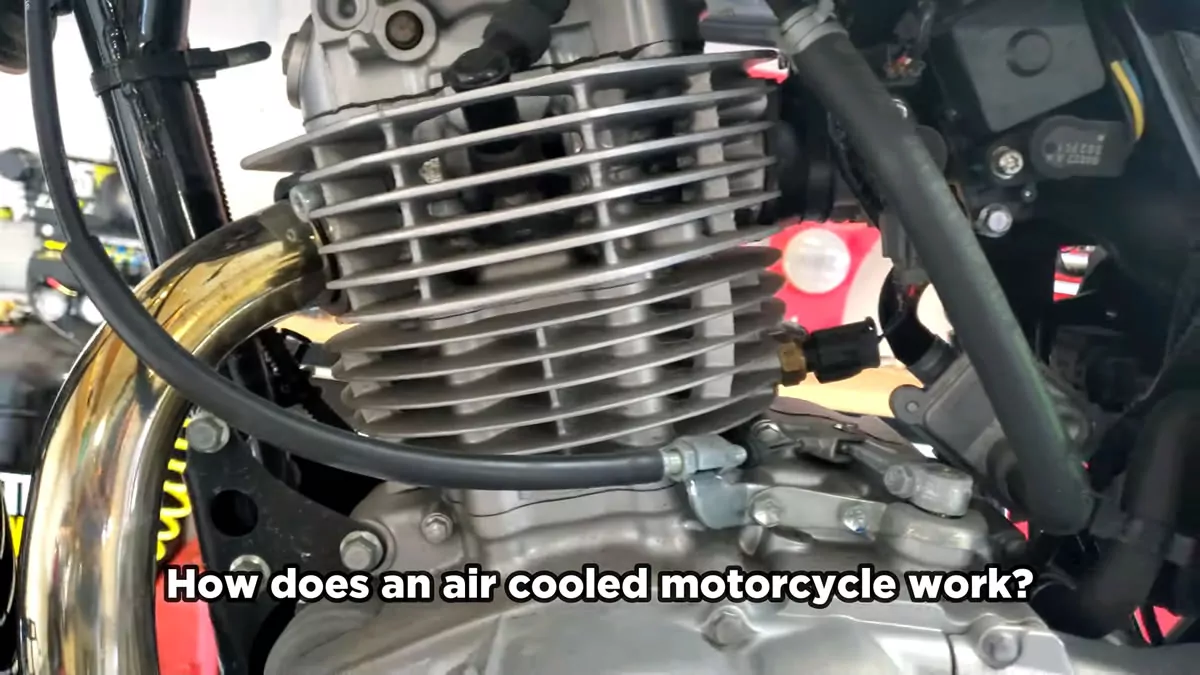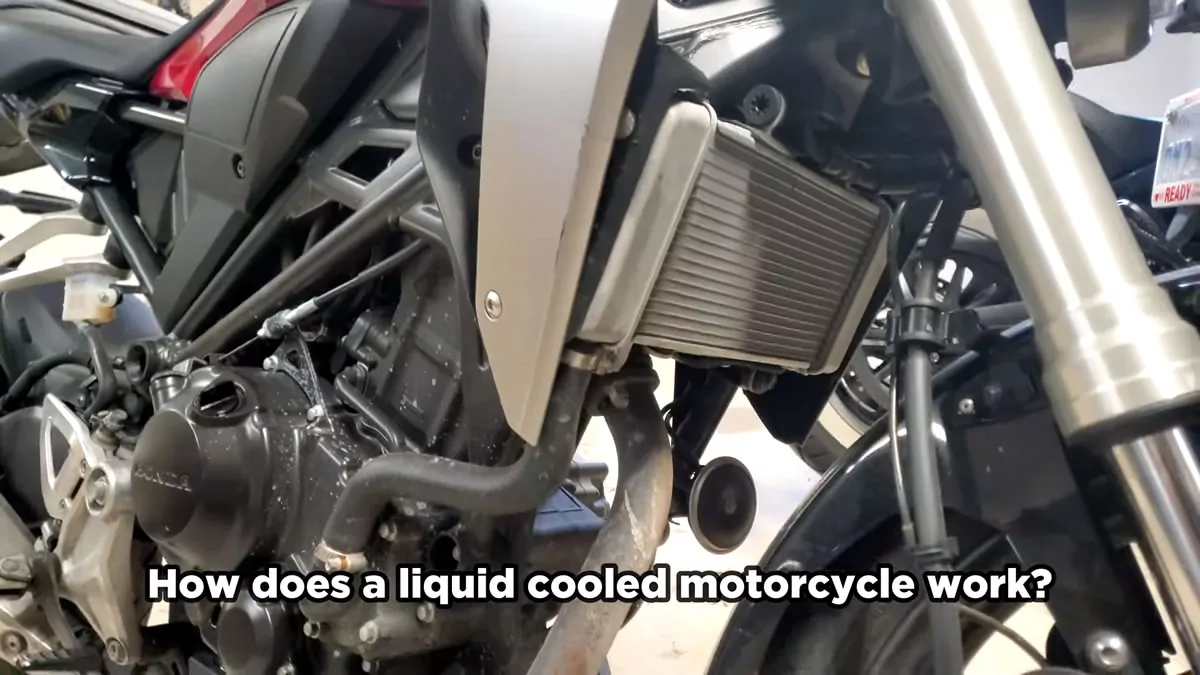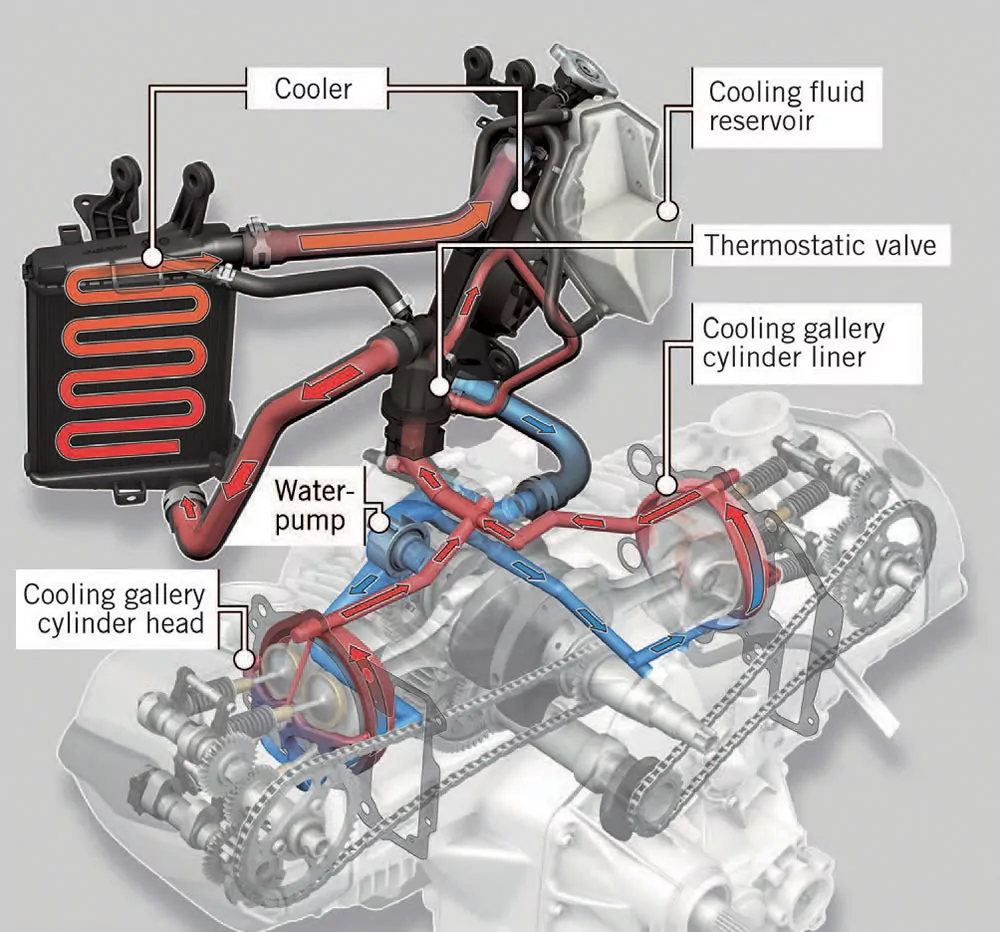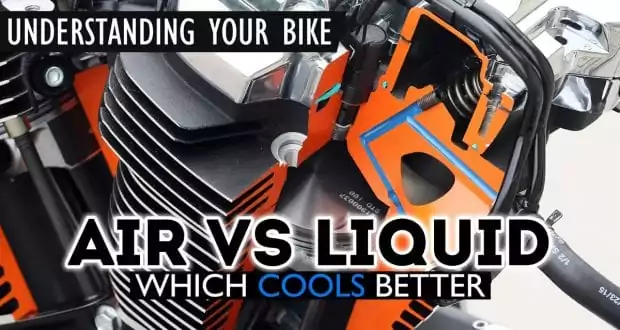What’s the difference between liquid cooled and air cooled motorcycles? If you’re asking this question, I’m going to assume that you’re looking to buy a motorcycle and you want to figure out things like:
- Why do motorcycles need to be cooled?
- How do air cooled and liquid cooled motorcycle systems work?
- How are air cooled and liquid cooled motorcycles different?
- Which one is better and which one is right for me?
This article on liquid cooled vs. air cooled motorcycle engines will be aimed at total beginners, so feel free to scroll down to whatever section(s) are most relevant to you!
Liquid cooled motorcycles and air cooled motorcycles take different approaches to how they handle eliminating the heat your motorcycle generates. These differences, and the pros and cons of each, are what we’ll be talking about in this video.


Why do motorcycles need a cooling system?
Before we get talk about whether air cooled engines are better than liquid cooled engines, or whether liquid cooled engines are better than air cooled engines, we should talk about engine cooling in general, and how each type of motorcycle engine handles that function differently.
Your engine works through a series of miniature explosions. These explosions produce a ton of heat, after all, you’re literally “burning gas”. According to scientific research (Wikipedia), only 44% of the heat generated escapes through your exhaust pipes. So what about the other 56% of the heat your motorcycle engine produces? With so much heat being generated, your motorcycle needs a cooling system to deal with all of the heat generated, otherwise it would suffer from irreversible damage, like premature wearing of gaskets and seals, or even seizing parts in place.
How do air cooled motorcycles work?
Air cooled motorcycles have a lot of little wedges, called cooling fins, which increase contact area of the motor with passing air. Air cooled motorcycles work by having air passing over these cooling fins, in order to wick away some of the heat.

Take a look at this air cooled engine, it’s from a Suzuki TU250. All of the cooling fins help the heat to dissipate, and create much more surface area for cool air to touch. Air cooled engines like this one rely on the circulation of air directly over and through these cooling fins. It’s similar to standing in front of a fan on a hot day: the more you can get in front of the fan, and the more air you have blowing, the cooler you’ll be.
Air flow passing over the cooling fins will eliminate about 12% of the heat an air cooled engine generates. If it’s a windy day, or you’re moving quickly, that’s great. If you’re stuck in gridlock on a hot day, your air cooled motor won’t help much.
Now let’s compare that to how a liquid cooled engine works.
How do liquid cooled motorcycles work?
This is a Honda CB300R, it uses a liquid cooled 286cc motorcycle engine. You’ll notice, it has a few extra parts that the air cooled bike doesn’t. First, there’s a radiator, behind it, there’s a fan, in between and all around that are hoses with coolant inside, and somewhere in the middle of all of this is a thermostat.

A liquid cooled engine doesn’t need the cooling fins of an air cooled engine. Instead, inside the engine are a series of channels, like a little underground plumbing system, that coolant flows through. When the thermostat detects that the engine is getting too hot, your fan turns on, it pulls air through the radiator, the airflow through the rad cools the coolant, which is then pumped through the motor and then back into the rad to be re-cooled and re-pumped. The system stops once the engine has cooled back down to within operating range.
Do air cooled and liquid cooled motorcycles perform differently?
Yes, air cooled and liquid cooled motorcycle engines perform very differently. Let’s take a Moto Guzzi V7 and a Triumph Street Triple as a comparison:
The air cooled 750cc Moto Guzzi V7 makes 50 horsepower at 6,200 RPM. The Triumph Street Triple is smaller, at 675cc, but it makes about 106 horsepower at 11,750 RPM. The Speed Triple makes double the power, despite being power 10% smaller, because it can rev higher up without fear of overheating thanks to it’s liquid cooling. Liquid cooling allows the Street Triple to consistently stay cooler, even in traffic.
What are the advantages of air cooled motorcycles?
By not having hoses, a thermostat, or a radiator, an air cooled motorcycle is simpler and could save you money by having less parts that could break, wear, or fail. Having less parts that can fail means that one could make the argument that air cooled motorcycles would be more reliable then liquid cooled motorcycles. Not having any coolant also means that air cooled motorcycles don’t require you to change the coolant every so often, so there is less maintenance to them.
Another way air cooled motorcycles can save you some money is that they are simpler to manufacture, and that savings is generally passed on to the consumer, as air cooled motorcycles tend to cost less to purchase new than their liquid cooled counterparts.
What are the disadvantages of air cooled motorcycles?
There are several disadvantages of air cooled motorcycles. Their ability to cool down your motorcycle is dependent on the motorcycle moving or being in wind. There is less control over the temperature of the motorcycle. The rider could get much hotter being over such a hot running motor. There is the potential for overheating and premature wear. You aren’t burning gas as efficiently or as cleanly, and air cooled engines also run richer, meaning they use more fuel to help keep the temperature down, while costing you a little more in gas.
Lastly, with air cooled motorcycles, you get less performance per cubic centimeter. That’s because air cooled engines are not tuned to give you as much power, in order to help avoid over-exerting (and therefore overheating) the air cooled engine.

What are the advantages of liquid cooled motorcycles?
One of the major advantages of liquid cooled motorcycle engines is that they allow you to get much better performance out of your motor. This is why small liquid cooled motorcycles will make much more horsepower than much larger air cooled motorcycles. That’s why Harley-Davidson makes their air cooled cruisers with huge engines.
Another advantage is the ability to regulate and control the operating temperature of your motorcycle’s engine to keep it within spec leading to not only better performance but longer life as well. In liquid cooled engines, circulating liquid coolant evens out hot spots in the cylinder head, which leads to better detonation control for cleaner emissions. You get a more complete combustion, but not so hot as to promote detonation or high NOx emissions, and better fuel economy, all of which makes the planet happy.
Lastly, liquid cooled motorcycles, because of the channels running through them, can dampen some of the sounds engines produce, so they tend to make less motor noise as well.
What are the disadvantages of liquid cooled motorcycles?
Liquid cooled motorcycles have their own list of disadvantages. The additional parts (hoses, thermostat, radiator) could all fail, break, or wear out. These could lead to repair costs that could potentially get expensive if a cooling system fails and the rider doesn’t notice and chooses to ride their motorcycle instead of getting it towed.
Having an additional fluid in your motorcycle also means you have one more fluid that can get old and need replacement. Coolant should be replaced every two years or every 20,000 miles, although personally I replace mine every 10,000 miles.
Liquid cooled vs air cooled motorcycle engines, which one is right for you?
If you’re someone who lives in a city like Los Angeles, San Francisco, New York City, Toronto, or anywhere where high traffic and gridlock aren’t uncommon, you should probably opt for a liquid cooled motorcycle, especially if you’ll be commuting to work on your motorcycle.
However, if you live pretty much anywhere else, an air cooled motorcycle isn’t the end of the world. Furthermore, the time of day you ride, and what your needs and wants from your motorcycle are may also influence your decision one way or another.
Which would I buy?
When I was a student, I sold my liquid cooled Suzuki Boulevard M50 to buy a Harley-Davidson Sportster 883 which I had been longing after for a long time. I was working two jobs in downtown Toronto, going to university in downtown Toronto, and going to see my father every day in a hospital in downtown Toronto. I hated my Harley-Davidson Sportster. Being stuck in gridlock on an air cooled bike was awful. I sold the Sportster and bought another used Boulevard M50.
But, at this point in my life, I’m self-employed, set my own hours, and pick where I will and won’t work. I no longer need to be downtown, so I would be satisfied with an air cooled motorcycle. In fact, I wouldn’t mind picking up an air/oil cooled motorcycle like a Ducati Monster or a Triumph Bonneville.
Other random liquid cooled motorcycle vs air cooled motorcycle tidbits:
– Some engine configurations do better with air cooling than others. For example, a big single cylinder or a parallel twin motorcycle engine would be well cooled on most sides, but a traditional v-twin engine wouldn’t get as much cooling on the rear cylinder as it would on the front. With liquid cooling though, each cylinder is cooled much more evenly.
– If you’re trying to get a classic motorcycle aesthetic, you just won’t get it with a bunch of plastic piled on in front.
– A popular argument for air cooled motorcycles is “I can ride my Harley all day long through the dessert and it never overheats!” That statement is usually 100% correct. However, that statement also suggests that the motorcyclist is riding, as in staying in motion, which means that the air cooled motorcycle is receiving a ton of air. Sure, dessert air might be hot, but compared to the gas-burning fire inside of your motor, it’s actually quite cool. Whereas the air cooled motorcyclist in the middle a mile long traffic jam, walled in by sky scrapers on either side, won’t do as well. Stop and go traffic + no breeze = no air cooling. That’s why you can ride your Harley all day long through the dessert, but that won’t make it good for bumper to bumper big city traffic.
Closing thoughts
It’s not that air cooled engines are awful. They aren’t. If you like a simple, classic looking motorcycle, air cooled motorcycles are fine. Sure, they pollute a little more and they don’t rev up as quickly or perform as well, but they look great.
On the other hand, if you want to get more from your motorcycle, there is no denying the truth: There’s a reason motorcycle racers only use liquid cooled motorcycles. They rev up higher, go faster, and still make you far less likely to have an engine overheat. Going as far back as the 1920s, motorcycle manufacturers have made liquid cooled engines for those wanting an advantage over the competition.
Which engine type is better? Is there anything you’d like to learn more about motorcycles? Let me know in the comments section!
 YouMotorcycle Motorcycle Blog – Motorcycle Lifestyle Blog, MotoVlog, Motorcycle Reviews, News, & How-Tos
YouMotorcycle Motorcycle Blog – Motorcycle Lifestyle Blog, MotoVlog, Motorcycle Reviews, News, & How-Tos

You forgot to mention water pumps on liquid cooled engines. Seals can leak. Liquid cooled engines run tighter internal piston to cylinder tolerances because of the more consistent and efficient cooling. In turn, they can run higher compression ratios (more heat but more power). Liquid cooled engines can have up to 13:1 compression ratios on factory engines. Air cooled is pretty much limited to 10:1. Same size for size engines – liquid cooled engines can generate more power.
The theoretical advantage of water cooled engines are undeniable. It will depend on what you are going to do with a bike. I don’t ride hard anymore and my bikes are old air cooled machines. Eventually, with emissions regulations tightening everything will be water cooled.
Agreed. I can get away with an air cooled bike now. Ten years ago it just wasn’t feasible for me based on where I was at in life.
Massive fan of the “old” air/oil cooled vibes! Rockin’ an ’07 BMW R1200R, unique with that air/oil combo and a temp gauge. Never had it overheat in traffic (thanks to that beastly oil cooler). Had a Triumph ST955i that’d overheat in a blink, and don’t get me started on the Honda XR650L – hit 325F like a sauna! Eyeing a new XR650L or a DR650 with some upgrades. Nostalgia hits hard with the XR200, never a hiccup. Old GSX750s? Cooler than a 1-ton truck!
Ever thought about tossing on a cooling fan on those air cooled bikes?
Yup, I’ve seen some company make aftermarket fan options made specifically for Harley-Davidson big twins. Pretty cool!
Thanks for your detailed explanations of the advantages and disadvantages of air-cooled versus liquid-cooled engines.
My bike is oil-cooled, what are the pros and cons of that? (I assume that by “liquid-cooled” you mean water-cooled.)
Hey John. I cover that in the video. You get a best and worse of both worlds. Some cooling benefit, but also some complexity/failure points from having a rad.
Thanks, I watched your video and that basically answers my question about your opinion on oil-cooling.
For the record, though, my bike has never overheated, not even the time a couple of summers ago when I went for a 200-mile ride on a 40-degree day (104 degrees Fahrenheit) and the last 20 miles were in bumper-to-bumper traffic. However, not surprisingly, I could feel the heat radiating off the engine much more than usual, it was like having an electric heater under my legs.
So, check it – liquid-cooled engines? They’re built with super tight tolerances and tuned for a smaller temperature range. Means they stick around longer, work more efficiently, and bring the power game. Like, triple threat vibes in the motorcycle world!